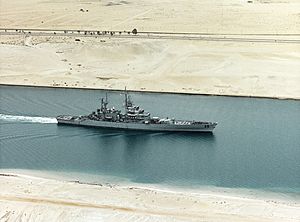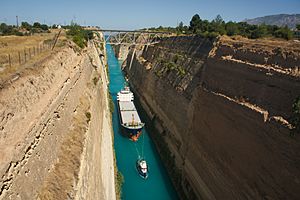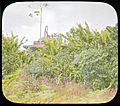Canal facts for kids

Canals are like special waterways or channels that people build. They are made to move water from one place to another, or to let boats and ships travel across land. Think of them as human-made rivers!
There are two main kinds of canals:
- Aqueduct canals: These are built to carry fresh water. This water can be used for people to drink, for farms to grow crops, or for other important uses.
- Waterway canals: These are like watery highways for boats and ships. They help transport goods and people, often connecting existing lakes, rivers, or even oceans. Famous examples include the Suez Canal and the Panama Canal, which connect huge oceans!
Some canals also help with irrigation, which means watering crops, or they can be used to create hydropower, which is electricity made from moving water.
Contents
Why are canals important?
Canals have been super important throughout history. They helped ancient civilizations grow by bringing water to dry areas. Later, they became key for trade and travel.
Connecting places and trade
Before trains and trucks, canals were often the best way to move heavy goods. They allowed boats to carry things like coal, timber, and food much more easily than by land. This helped towns and cities grow and made trade much faster and cheaper.
Famous canals around the world
Many countries have built amazing canals. For example, the Suez Canal in Egypt connects the Mediterranean Sea to the Red Sea, making sea travel between Europe and Asia much shorter. The Panama Canal connects the Atlantic and Pacific Oceans, saving ships a long trip around South America.
In Europe, cities like Amsterdam and Venice are famous for their beautiful canals, which are used for transport and sightseeing. In the United States, the Erie Canal was a huge project that helped connect the Great Lakes to the Atlantic Ocean, boosting trade and settlement.
How are canals built?
Building canals can be a massive job! Sometimes, engineers have to dig through mountains or blast through rock, like with the Corinth Canal in Greece. They also use special structures called sluices or locks.
What are canal locks?
Canal locks are like water elevators for boats. They help boats move between different water levels. If a boat needs to go uphill, it enters a lock, the gates close, and water fills the lock to lift the boat up. To go downhill, water is let out to lower the boat. This clever system allows canals to cross uneven land.
Images for kids
-
The Alter Strom, in the sea resort of Warnemünde, Germany.
-
The Royal Canal in Ireland.
-
Small boat canals such as the Basingstoke Canal fuelled the industrial revolution in much of Europe and the United States.
-
Bridge on the Naviglio Grande, in the town of Cassinetta di Lugagnano, in Italy
-
Canal in Broek in Waterland, Netherlands.
-
Canal in Venice.
-
Saimaa Canal, a transportation canal between Finland and Russia, in Lappeenranta
-
Loading Anthracite on the Lehigh Canal to feed the early United States industries in the pioneer-era.
-
The Danube-Black Sea Canal in Romania
-
The Amsterdam-Rhine Canal near Rijswijk, Netherlands
-
Canal de Castilla in Castile and León, Spain, is 207 km (129 mi) long, crossing 38 municipalities. Initially built to transport wheat, it is now used for irrigation.
-
The Grand Canal of China at Suzhou.
-
Thal Canal, Punjab, Pakistan.
-
Bridgewater Canal in England
-
Erie Canal, Lockport, New York, c. 1855
-
Aqueduct over the Mohawk River at Rexford, New York, one of 32 navigable aqueducts on the Erie Canal.
-
Sluice in the canal of Gabčíkovo Dam (Slovakia) – the canal is conveying water to a hydroelectric power station.
-
A proposal for the Nicaragua Canal, from around 1870.
-
A canal (Gracht) in Amsterdam, Netherlands.
-
Griboyedov Canal in St. Petersburg, Russia.
-
Aerial view of the man-made canals of the Gold Coast, Queensland, Australia.
-
Wharfs along the Oudegracht in Utrecht, Netherlands.
-
Canal of La Peyrade in Sète, France.
-
Two Panamax ships in the Miraflores Locks on the Panama Canal, Panama.
-
The flight of 16 consecutive locks at Caen Hill on the Kennet and Avon Canal, Wiltshire.
-
A canal boat traverses the longest and highest aqueduct in the UK, at Pontcysyllte in Denbighshire, Wales.
-
The Corinth Canal seen from the air.
See also
 In Spanish: Canal (ingeniería) para niños
In Spanish: Canal (ingeniería) para niños






































